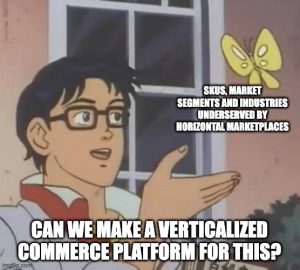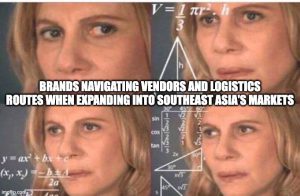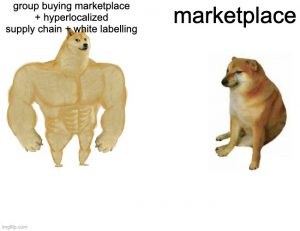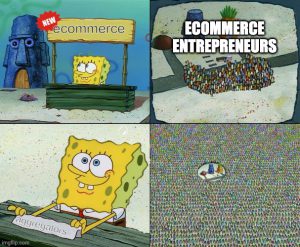Highlights
- Omnichannel commerce calls for more complex and nimble platforms to serve brands.
- Verticalized commerce spreads to more products and target markets, but the proof of its advantages is in the pudding.
- B2B commerce enablers thrive in increasing granularity and diverse customer bases, leveraging economies of scale in data accumulation.
- Social commerce sees increasingly diverse segmentation and complex models as platforms seek greater ownership of the value chain with growth.
- Community-first commerce is key to unlocking value creation and even profitability for verticalized commerce platforms and D2C brands/house of brands.
- Rise of the house of brands model and D2C brand acquisitions reshaping views on commerce entrepreneurship.
- Sustainable commerce opens up new types of products and production.
- A common thread across the seven variants discussed in this retrospective article is the increasing complexity in models and value propositions to meet the changing needs of consumers and brands. This increasing complexity has also deepened the potential socio-economic impact of these platforms. This means there will be more acquisitions across brands and platforms to build up these ecosystems to meet complex needs. There will also be more space for blue oceans to be found and developed by emerging platforms.
Southeast Asia’s digital economy, and its explosion in recent years, has historically been driven by ecommerce marketplaces. But it’s clear that as Southeast Asia’s pool of entrepreneurial talent and capital-seeking entrepreneurs has grown, innovations in commerce (or the way that physical/offline goods and services are delivered from seller to buyer) have gone well beyond these marketplaces.
Since Insignia Business Review was launched in 2019, we’ve written about the rise of the various forms of social commerce, verticalized commerce, commerce enablers, D2C commerce, and quick commerce, among many other variants.
And now in 2022, some of these emerging variants continue to see more growth than others, while newer variants have also come into the fold.
This momentum has been driven by transitions this year: concrete transitions to post-pandemic consumer behaviors (from purely online to hybrid), transitions in digitalization needs of the business (from experimentation to consolidation of tools and tech stacks), and transitions in investor preferences in terms of the quality of company financials, capability to achieve/maintain profitability, and corporate governance.
In turn, these transitions in consumer behavior, digital transformation for businesses, and investor preferences have influenced the kinds of venture-backable commerce variants that continue to thrive from previous years and have also newly emerged.
In this article we cover seven variants of commerce, some direct “upgrades” of the horizontal ecommerce marketplace (again, given the transitions to consumer behavior and business practices over the years) while others target the “gaps” that these horizontal marketplaces have left untapped:
(1) Omnichannel commerce calls for more complex and nimble platforms to serve brands.
What the post-pandemic behavioral shift from purely online to hybrid activities has resulted in is an expansion of brands from purely online distribution or O2O distribution to omnichannel distribution.
Brands are always on the lookout to build a presence where their customers frequent. In recent years, this has put digital-first brands at an advantage, but the post-pandemic transition has seen traditional brands moving into online channels in addition to their offline ones. This has meant that platforms and marketplaces connecting brands to customers or enabling brands to reach more customers are hardpressed to build beyond just online channels, but also considering the increasing dominance of social media in the ecommerce journey, as well as offline or physical stores.
The challenge for platforms serving these brands here is how to still ensure cost-efficient expansion into omnichannel distribution. This has to consider both traditional and new brands, which may seem to be opposing in the direction of their distribution expansion (the former going online and social media, the other considering offline as well). In this way leveraging local infrastructure or partnerships may be a way in for some companies.
Konvy CEO Gui Huang shares on the podcast: “10 years ago, e-commerce was new. No one knew how to sell online. But talking about today, everyone knows how to sell online. Now how can Konvy adapt to the ecosystems of beauty and also e-commerce and now we are leading a lot of innovation on how people should shop online…With the consumer insight that we learn on one side, and the other side with the information that we get from the brands, we are able to come up with new models, new strategy to tackle the new consumer behaviors…Three years ago, the problem [brands] faced was that marketplace was booming, but they had no individuals in their company to handle marketplaces. But today, they do have a team for the marketplace now, but now the challenge is that social commerce is coming. TikTok is coming. What should [they] do?”
(2) Verticalized commerce spreads to more products and target markets, but the proof of its advantages are in the pudding.
Verticalized commerce in more specific/traditional sectors has also continued to have stronger investor interest, with the potential for verticalized platforms to have more monetization options, stronger retention, and deeper competitive moats through localization.
What is interesting is how widespread the verticalization of commerce is, even within our own portfolio, from platforms like CARRO (we write a mini-case study on how they achieved profitability this ‘FY 22 and became the leading auto retail platform in the region) and Pinhome (revisit our most recent podcast with founders Dara and Ahmed on becoming a growth-stage company) which have continued to see growth on top their end-to-end transaction + after-sales ecosystem of services for cars and property respectively to emerging platforms Tentang Anak (they officially launched their app and ecommerce services this year) building for the entire parenting journey with their education and ecommerce platform for Indonesian parents.
The whole point of verticalization is to diversify in a cost-efficient and user-friendly way, so ensuring that the starting point can bring enough firepower to expand further the customer journey or value chain is a key challenge for commerce platforms.
(3) B2B commerce enablers thriving in increasing granularity and diverse customer bases, leveraging economies of scale in data accumulation.
When it comes to B2B, the complexity of transactions, processes, and paperwork, especially when brought to a cross-border level, can’t simply be solved with the two-sided marketplace model.
While B2B commerce enablers may start with covering a single type of transaction, that is ideally just a go-to-market to capture activity and data to eventually provide more granularity and meet more diverse use cases along their target industry’s supply chain.
While some enablers are tackling the B2B commerce opportunity from an industry standpoint, simply because the market opportunity in these individual industries is already so massive, other B2B commerce plays revolved around a focus on specific transactions or functions. For example, there is Eezee focusing on the procurement transactions of organizations across industries and markets, or Janio Asia focusing on optimizing the logistics management and decision-making processes of brands of various sizes.
Regardless if the approach is to optimize an industry’s transactions or a specific process or transaction across industries, the trajectory for these enablers is to be able to efficiently capture more of their customers’ wallet or long-term transaction value by either expanding into more adjacent services (the operating software for X approach parallel to B2C verticalized platforms) and/or more use cases (leveraging economies of scale of data accumulation and deeper network partnerships and integrations).
Janio Asia CEO Junkai Ng shares on the podcast: “…one of the core metrics we go after is not really just pure revenues, but how can we grow their share of wallet with them over time? Regional clients kind of give us a lot more leverage and we can act better as their advisor in terms of how they should map out their supply chain decisions…Regional players tend to have a more complex supply chain strategy and they’ll think a bit more long-term in terms of where they should go…we kind of thrive in complex issues. That’s kind of how our systems are built because we are built modularly in nature, right?”
(4) Social commerce sees increasingly diverse segmentation and complex models as platforms seek greater ownership of the value chain with growth.
Because social commerce comes in many different forms, it will depend on how the company has leveraged the social aspect to carve out significant transaction value on their platform, as well as the type of SKUs and market segment the social commerce platform is targeting (i.e., the product-market fit).
Over the years, this has led to increasingly diverse segmentation of target SKU (e.g., targeting FMCG, fresh produce, fashion, or even mom and baby segments) and complex models (e.g., group buying, marketplace, supply chain, white-labeled D2C) across social commerce platforms.
For example, Super’s initial focus on FMCG products in tier-2, tier-3, and rural Indonesia helped to establish themselves in a large market with a retentive demand. Then they leverage the “social” aspect through a network of local agents, micro-fulfillment centers, and warehouses in strategic areas that enables them to price products competitively. More recently, with this social distribution repeatable and well-established, Super has looked to the SKU side for innovation, introducing their own white-label brands.
What Super’s journey thus far as a social commerce platform points to is the investability of social commerce is tied deeply to the community behavior being tapped into by the social aspect of the platform. Social commerce leaders in different markets are also likely to emerge along these lines of target communities and SKUs. What is also interesting to anticipate is the evolution of social commerce from a pure platform to incorporating D2C business in order to have greater ownership over the value chain.
Super CEO Steven Wongsoredjo shares on the podcast: “In the end, it’s like an art of jiu-jitsu that we’re playing here, so people think when they are fighting Super, they’re fighting with this e-commerce general player. But hey, wait, actually, this guy is actually also a privately labeled brand that actually has an FMCG kind of like angle that has very strong revenue. Then people think that they would like to file us in the FMCG category, but hey, actually this guy has network effects on the ground and is utilizing these local vendors in distributing the product…And in the end, the big vision of the company is we would like to become the Walmart of Indonesia, without having the presence of retail stores and having a very efficient [supply chain] on the ground.”
(5) Community-first commerce is key to unlocking value creation and even profitability for verticalized commerce platforms and D2C brands/house of brands.
With the rise of verticalized commerce focused on specific market segments or product categories, a common thread across the go-to-market strategies for these companies has been to build communities. And in the case of second-wave ecommerce in the region (i.e., nongeneralist marketplaces), this community building is often done in tandem with or even prior to rolling out any product or service to this community. Building communities is often done to achieve one or more of the following:
- Build a brand and validate monetization potential, especially for go-to-market strategy
- Create a mine of data and insights from which to then develop personalized consumer experiences
- Educate the market and build trust in products or services that change the status quo
- Reduce customer acquisition and overhead costs to scale more cost-efficiently and reach profitability
Some examples of how communities are channels that achieve the goals mentioned above:
- Expertise (Community as a Channel that Builds Trust): This could range from having trusted domain experts like doctors as influencers in or simply part of the community, to partnerships with institutions like governmental organizations, or even rolling out ISO-certified products. Because consumers are buying into information and insight, this helps build longer retention and over time decouples their customer journey from any single product and ties it to the platform instead.
- Relationships (Community as a Channel that Builds Brand at Scale): D2C startups usually tap into these relationships through loyalty or beta-testing programs (relationships with the product), group buying (relationships with fellow members), or referrals (relationships with potential members). By leveraging these relationships, D2C startups are able to reduce both churn and customer acquisition costs over time, as the engagements like the ones mentioned above are deeply rooted in the desire for shared experiences, image-building, influence, or simply fitting into a group.
- Feedback Loop (Community as a Channel that Contributes to Product Development): This could involve having a captive group of early adopters that is maintained over time, or having product teams in the company work more closely with marketing channels to generate and make use of insights directly from users. And so these communities become a “shadow product development team”, not just providing insights at scale, but in some cases also becoming a source of future hires.
Read about the rest in our article on “5 Elements Of D2C Community Building For Capital Efficient Scale In Ecommerce”
(6) Rise of the house of brands model and D2C brand acquisitions reshaping views on commerce entrepreneurship.
A combination of the rise of ecommerce enablers and the demands of omnichannel distribution have opened up opportunities for the “house of brands” model to make its way into ecommerce, with the likes of Rainforest acquiring ecommerce brands to get them to the next level of growth. Ecommerce has evolved from just being platforms for products to being platforms for entire brands and end-to-end brand growth.
For brands looking to level up their expansion and the back-end needed to support this, ecommerce brand aggregators like Rainforest come into the picture. But the idea of companies buying out other brands and then taking them to the next level is nothing new. There are companies like Helen of Troy or LVMH that have long been acquiring or developing brands. The difference with the digital-first approach is that the resources needed and benchmarks used for a successful brand require a team and approach fit for the world of ecommerce.
The obvious challenge for this approach is juggling this portfolio of brands, balancing out acquisitions versus development (for some platforms that do this), and taking into consideration the company’s expertise and distribution channels.
(7) Sustainable commerce opens up new types of products and production.
The increasing awareness from consumers about the social, economic, and environmental impact of their consumption has led to the wider adoption of next-generation products and production. One of the more well-known examples is alternative protein products, with the likes of Float Foods commercially launching their flagship brand OnlyEg this year.
The foundations for a plant-based food tech to scale are not out-of-this-world. In fact, these could very much apply to many businesses looking to commercialize globally. What sets Float Foods and many other food techs’ situation apart is (1) the very nature of the product being both familiar (many people eat eggs) and unfamiliar (not nearly as many people eat plant-based) to the global market, (2) the combination of inherent constraints and pace as a startup, and (3) the diversity in ecosystem components for plant-based adoption in various markets (e.g. Singapore is more on the supportive side when it comes to plant-based).
The challenge for these “frontier” products is that because they are developing these products from scratch, there needs to be a balance between R&D and commercialization spending. And of course, because these products are often positioned as substitutes to widely used, status quo, often low-cost behaviors, then commercialization is not just a matter of selling the product but bringing down costs over time.
Increasing Complexity and Socio-Economic Impact
A common thread across the seven variants (omnichannel commerce, verticalized commerce, B2B commerce enablement, social commerce, community-first commerce, D2C / digital house of brand commerce, and sustainable commerce) discussed in this retrospective article is the increasing complexity in models and value propositions that platforms businesses are taking to meet the changing needs of consumers and brands.
At the same time, this increasing complexity has also deepened the potential socio-economic impact of these platforms, from increasing incomes of consumers (agent model in group buying), to improving logistics efficiencies which then lead to lower costs of goods, or simply addressing longstanding fragmentation in value chains of fisheries, fashion, or even parenting.
What this means for the competitive landscape is twofold. There will be more acquisitions across brands and platforms to build up these ecosystems meeting complex needs. There will also be more space for blue oceans to be found and developed by emerging platforms. Both bode well for the prospects of capital and talent looking to participate more actively in Southeast Asia’s ever-evolving commerce landscape.
Paulo Joquiño is a writer and content producer for tech companies, and co-author of the book Navigating ASEANnovation. He is currently Editor of Insignia Business Review, the official publication of Insignia Ventures Partners, and senior content strategist for the venture capital firm, where he started right after graduation. As a university student, he took up multiple work opportunities in content and marketing for startups in Asia. These included interning as an associate at G3 Partners, a Seoul-based marketing agency for tech startups, running tech community engagements at coworking space and business community, ASPACE Philippines, and interning at workspace marketplace FlySpaces. He graduated with a BS Management Engineering at Ateneo de Manila University in 2019.






